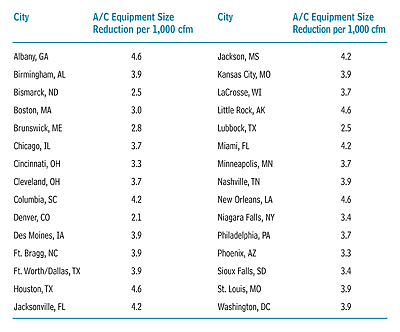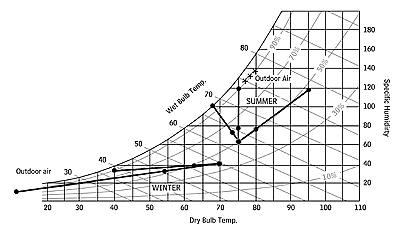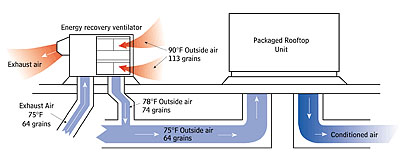To handle the higher quantities of ventilation air with the conventional system, the designer typically increases the equipment's cooling and heating capacity. Although the higher energy bills are undesirable, an even greater problem is humidity control, primarily during the cooling season.
Most cooling systems energize the cooling coil based on room temperature, ignoring room humidity. As a result, ventilation rates that are adequate to dilute space contaminants may contribute to high indoor humidity and also stimulate microbial growth.

A Ventilation Challenge
If you take a quick look around your community, you can probably find a good candidate for an energy recovery ventilator: a structure that was designed and constructed according to the codes and regulations of the 1970s and 1980s.Alexander Elementary in Houston is a perfect example. Like many schools constructed in the early '80s, Alexander Elementary was designed to conserve energy. An energy-saving approach endorsed by the industry at that time was the reduction of outdoor air ventilation to 5 cfm per person, thereby reducing the amount of energy needed to condition the outdoor air. Unfortunately, that effort to save energy in the '80s prevented the school from meeting today's ASHRAE Standard 62-89 of 15 cfm per student. And, depending on the school design, Houston's code can require even more outdoor air.
To comply with the local code, the district needed to quadruple the amount of outdoor air entering the Alexander school. The Alief Independent School District (ISD) also wanted a reliable ventilation solution that would fit its budget, be easy to maintain, and help control indoor humidity - always an important concern in the humid Houston climate.

Alexander's Solution
The hvac engineering team determined that the best solution to address the needs of Alexander Elementary was to incorporate rotary energy recovery ventilators (ERVs) into their existing system. Five roof-mounted ERVs were selected to provide 20,215 cfm of outdoor air to the school. Four served classrooms, and one served the gymnasium and cafeteria areas. Existing air handlers and chillers were used. Installation required little additional ductwork to connect the ERVs to the return ducts.This equipment preconditions the outdoor air by recovering energy from air being exhausted from the building. Enthalpic energy recovery efficiencies typically range from 70% to 80%. The preconditioned outdoor air is then injected into the return duct and supplied to the room spaces using the existing air distribution system.
Data for the gymnasium/cafeteria unit quantifies both sensible and latent energy transfer performances. Outdoor air volume is 4,900 cfm and exhaust air volume is 4,345 cfm. Summer design was 95°F db/78°F wb for outdoor air and 75°F db/62°F wb for room air. At 75% effectiveness, the ERV leaving temperatures were 80°F db/67°F wb, reducing the air conditioning load by 18 tons. At winter design, the ERV heats the outdoor air from 20°F db to 59°F db.

Why an Energy Recovery Ventilator?
A total enthalpy energy recovery ventilator (ERV) is an energy recovery wheel that transfers the temperature and moisture properties from exhaust air to ventilation air. Outdoor air is preconditioned to near room temperature and humidity, reducing the outdoor air load by up to 85%. An outdoor air fan ensures that adequate ventilation is injected into the system at full-load or part-load conditions. A separate fan exhausts air from restrooms or other spaces.Total enthalpy ERVs are well-suited to help control humidity. In the summer, when outside humidity is high, the energy wheel dehumidifies the outside air. This greatly reduces the latent load on the air conditioning equipment. It also eliminates the problems stemming from high moisture levels that can occur in hot humid climates. In the winter, when outside air is dry, the energy wheel humidifies the incoming outside air.
ERVs aptly received their name because they are said to reduce utility bills. By recovering up to 85% of the energy of the exhaust air, far fewer energy dollars are spent cooling and heating the outside air supplied to the building.
Another way ERVs may save money is by helping to reduce the size of necessary air conditioning equipment. The ERV effectively reduces the outside air design conditions. For example, if outside design is 95°F db/78° wb, an 80%-effective energy wheel would precondition the outside air to 79°F db/66.1°F wb, which results in a load reduction of 3.9 tons for each 1,000 cfm of outside air.
Table 1 displays tons of cooling equipment size reduction with ERV for various cities in the United States. The powerful function of the total enthalpy energy wheel is that it works on any outside air condition. Whether at full load or part load, high or low relative humidity, winter or summer, the wheel transforms outside air into near room conditions. The psychrometric chart in Figure 1 illustrates the energy wheel's function for both winter and summer.
These performance characteristics become extremely beneficial during summer part-load conditions. At a summer outdoor morning condition of 75°F and 95% rh, conventional a/c equipment alone will be unable to control indoor humidity. Here is where the wheel really shines.
(Note the summer condition marked with *** on the psychrometric chart. The wheel performs a purely dehumidifying function, lowering the moisture level. This helps control indoor humidity, even as the compressor cycles on and off.)
School Savings
The Alief ISD saved substantially with the ERV's installation. Although the outdoor air volume quadrupled, the cooling and heating loads were only slightly greater. Without energy recovery, the outdoor air load would have increased by an additional 68 tons. The cost of the ERV was offset almost entirely by the avoided cost of purchasing additional air conditioning capacity.Energy savings are another benefit that ERVs provide. Alexander Elementary will realize over $9,500 in annual savings for cooling and heating. These savings, along with the avoided air conditioning costs, result in a payback period of less than one year.
Low maintenance requirements were also met. Quality blowers and galvanized steel cabinetry ensure reliable airflow performance. The enthalpy wheel transfers moisture in the vapor phase, eliminating the need for a drain system. Also, the wheel is self-cleaning because it continuously rotates between counterflowing airstreams. Suggested maintenance is changing of the outdoor air filters and annual inspection.
System Design
Designing a system with an ERV is similar to a conventional design. Two minor differences are illustrated in Figure 2.First, the ERV replaces the exhaust fan. Second, outdoor air enters the ERV and is preconditioned by the wheel, rather than entering the air conditioning unit directly. In most cases, the exhaust and supply ductwork do not change. A short run is typically required to duct outdoor air to the return duct.
ERVs also work nicely in systems with economizer operation. Again, it is similar to a conventional system. In minimum outdoor air mode, the operation is as shown. When conditions call for an economizer, the outdoor air fan in the ERV is de-energized and outdoor air enters a typical economizer section on the air conditioning unit.
Within the past several years, manufacturers have standardized ERV designs, resulting in high-quality, economically priced products. This, combined with the air conditioning downsizing and energy savings, makes ERVs extremely economical for many climates. Payback is immediate for projects in the southeastern U.S. and much of the Midwest.
The reliability of energy wheels has improved dramatically in the 1990s. Wheel designs are based on the most advanced technologies, which maximize thermal performance and mechanical life.
Several manufacturers are providing standard warranties of up to 10 years on the energy wheel and drive system. Complete ERV packages are now designed specifically for commercial and institutional applications, with minimal service in mind.
Some key features to keep in mind for commercial and institutional ERVs are:
- High latent transfer effectiveness for humidity control (in the range of 70% to 80%);
- ARI-certified effectiveness ratings (coming soon);
- AMCA-certified air performance ratings;
- Desiccants embedded into wheel media for long life; and
- Low maintenance, with easy service design.
Summary
With today's strict guidelines in building ventilation codes and a price-sensitive market, an energy recovery unit is a practical solution.ERVs enable system designers to comply with ASHRAE 62-89 while controlling indoor humidity and costs. The latent energy transfer capabilities translate into significant air conditioning load reduction, and help control indoor humidity during part-load conditions. System designs with ERVs offer proven, low-maintenance equipment and a system that is similar to traditional hvac designs. ES
